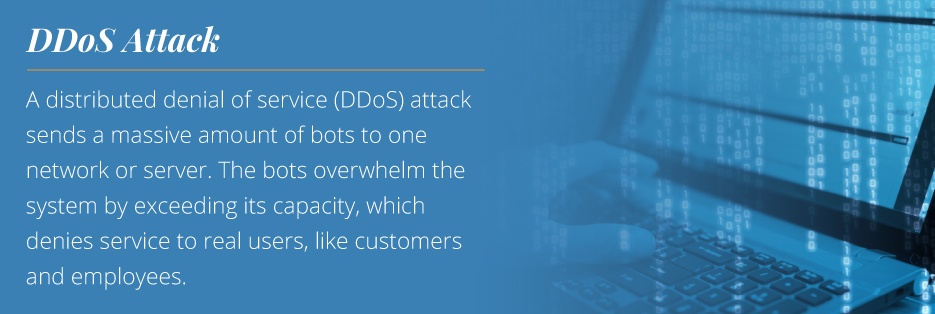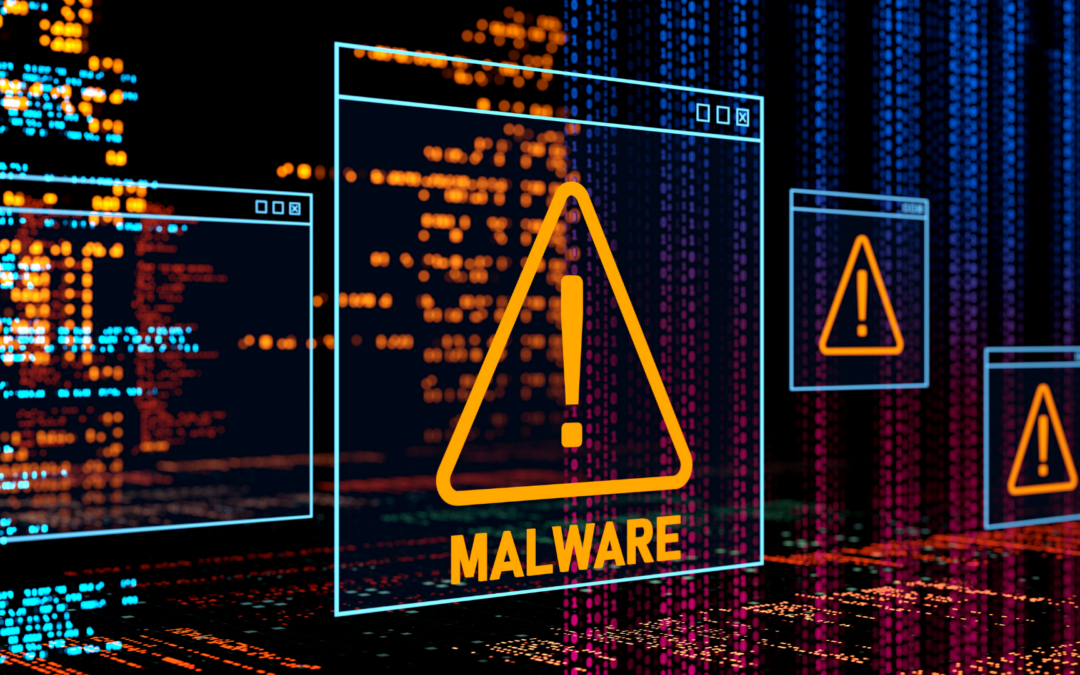Your business is a well-oiled machine. But what happens when someone throws a wrench in it? The threat of cyberattacks is more prevalent than ever, coming from a variety of sources. Well-meaning employees and malicious hackers alike can team up and cause massive damage to your enterprise.
No business is exempt. Almost half of all cyberattack victims in 2018 were small businesses, with fewer than 250 employees. Even large enterprises are prone to attacks. Just think of any number of data breaches that have hit the news in the last few years, like those at Target, Equifax and JPMorgan Chase.
Taking the time to review your company’s cybersecurity practices can save you from a disastrous situation later on. The recovery from a cyberattack can be costly enough to put a small business out of commission. Taking precautions can keep you in business if you become a victim of a cyberattack.
Cyberattack Types and Causes
A wide variety of cyberattacks can target different aspects of your system. Some are more preventable than others, but all require a plan if you want to protect your assets. Keep reading in the next sections for more information on preventing the following causes of cyberattacks.
1. Malware
Malware covers different types of malicious programs that breach a network through some vulnerability. You may find this vulnerability in security oversights or lax operating procedures. Malware can have a wide array of effects, including rendering the network useless, collecting data and even remotely controlling a system.

- Ransomware: According to Verizon’s 2019 Data Breach Investigations Report, 28% of breaches involved ransomware. While less discussed, it is still a leading type of malicious software and worth your attention. It works by encrypting the files on a business network so users can’t access them anymore. Then, the malware generates a message asking for a certain amount of money by a specific time. Unfortunately, as with most negotiations of this nature, there’s no way to tell whether the attacker will release the encryption after you’ve paid the ransom. Preventing this type of attack and keeping backups can be especially valuable.
- Spyware: Spyware often goes undetected. It runs in the background of a system, collecting and transmitting data to the hacker. This attack can pull information like passwords, authentication information, client data and other sensitive items. Downloads, viruses and Trojans are typically the sources of spyware.
- Viruses, worms and Trojans: Viruses are the most common type of malware and can execute itself, spreading by infecting other files. Worms are self-replicating and can spread on their own, without any signal from an operator. Trojan horses hide in legitimate-looking programs and launch upon installation and execution of the application. You can prevent these through scanning software and following best practices.
- Mobile malware: Malware on mobile devices is becoming an increasing concern as more workforces implement bring-your-own-device policies. Unauthorized applications, malicious links and Bluetooth and Wi-Fi connections are all routes malware can use. These are much more common on Android devices and may or may not interrupt your regular usage. Some signals to look out for include a spike in data usage, unfamiliar texts and emails being sent from the user and a battery that drains much more quickly than usual.
2. Cryptojacking
In this type of malware, an attacker uses the resources of another business to mine for cryptocurrency. It can siphon valuable resources from your system and cause slow performance. AdGuard estimates thousands of websites with a total of a billion monthly visits have fallen prey to cryptojacking. Cryptojacking may not be as concerning as other forms of malware since it doesn’t steal your data, but it is still something to watch out for.
3. DDoS Attacks
A distributed denial of service (DDoS) attack sends a massive amount of bots to one network or server. The bots overwhelm the system by exceeding its capacity, which denies service to real users, like customers and employees. Often, a DDoS attack works as a distraction while the hackers accomplish other tasks. Attackers may use it as an opportunity to inject malware or steal data while IT is working to resolve the DDoS damage. One of the most significant DDoS attacks hit GitHub, a development and coding platform, in 2018. In the attack, 1.35 terabits per second targeted their servers at once. They managed to stay online, though intermittently, through an intermediary company that helped them weed out the bots and false data.
DDoS attacks can be difficult to defend against, because there are several different types, including volumetric, application-layer and protocol, that target different areas of a server. Some precautions you can take include increasing your bandwidth capacity and blacklisting malicious IP addresses. Advanced network protection will combine several different methods of DDoS defense to keep your network up and running. Some cloud-based solutions can offer significant protection at reasonable costs for small and medium-sized businesses where more advanced in-house protection might be difficult to manage.

4. Gaps in Security
This year, Verizon reported 52% of data breach incidents were due to hacking. These were direct intrusion attempts from outside parties with the intent of bypassing network security. Hacking usually targets a significant gap in your system security. If security protocols don’t apply to every asset of your network, you open up the entire thing to malicious attacks. Think of your network as being only as strong as its weakest link. That weak link often provides hackers with a backdoor to all of your sensitive data.
As an example of this, JPMorgan Chase’s data breach in 2014 may have been a result of a gap in security. The New York Times explained Chase’s security team hadn’t upgraded one of their network servers with dual-factor authentication, which created a point of vulnerability and allowed access to confidential information. Ensuring consistent protection across your network is something to take very seriously.
5. Internet of Things
With this “weak link” in mind, the Internet of Things (IoT) can become a significant problem if not handled carefully. The IoT refers to items that connect to the internet, like smartwatches and voice assistants. These easily overlooked items can generate a simple backdoor for hackers.
As IoT devices rose in popularity, the FTC released a report detailing steps businesses should take when using them. Recommendations included building security into devices at their outset, training employees on the importance of security and implementing methods to keep unauthorized users out of the network.
More businesses are using smart devices like security cameras and smart automation procedures in everyday operations. These devices can become possible exploits if not maintained and updated frequently.

Importance of Cybersecurity in Business
Many owners of small or medium companies assume that due to their size, they won’t be victims of cyberattacks. In reality, small businesses are some of the primary targets. Small and midsized businesses tend to have less robust security protocols, but they still have a lot of valuable resources and data in the eyes of hackers. These companies also are less likely to have extensively trained staff or dedicated IT departments, making them easy targets.
Different businesses have different risks associated with cybersecurity. Medical and financial institutions need much more advanced systems than a retail store, for instance. All companies still need to abide by their responsibility to their clients. If you take any sensitive information, from addresses to Social Security numbers, you must keep them protected. You want clients to be able to trust you, not know your name from a headline about a data breach.
While the principle of a robust cybersecurity plan sounds good, in practice, it can be challenging to implement. The costs associated with cybersecurity won’t immediately boost profits or increase your efficiency tenfold, but that doesn’t mean it isn’t a necessary investment. Defending against cyberattacks protects you from something that could be debilitating to your company. For a small business, a ransomware attack may be the difference between maintaining regular operation and going out of business. The National Small Business Association estimated small businesses lost $32,000 in 2015 to hacks to their business banking accounts.
Cyberattacks can also become a legal problem if you don’t have a security plan in place. If you were to experience a data breach, you could be liable for not protecting your clients’ information well enough. By understanding any weak points in your system and spelling out best practices to follow, you can protect yourself more. These measures allow you to say yes, you did take steps to prevent a cyberattack. Your clients expect you to have reasonable safeguards in place to protect them.
Having a plan is a vital part of addressing your cybersecurity approach. This policy should cover the measures you put in place to train employees, beef up infrastructure and monitor and enforce your status each day. Another aspect you need to cover is your response plan. This plan will outline how your employees and company will react if a cybersecurity attack occurs. You might want to hire a cybersecurity consultant to create this plan, as well as an outside agency to take over if your company becomes a victim.
Ask yourself if your business can stand up to a cyberattack at this very moment. If the answer is no, you may benefit from improved infrastructure and business cybersecurity insurance, to keep your company moving forward in the event of an attack.
Protecting Your Business Against Cyberattacks
Regardless of the size or scope of your business, you can prevent or minimize the effect of cyberattacks through several techniques. Many of them are simple practices that prevent massive crises for your business.
- Prevent human error: Many kinds of malware infect their host system through a well-intentioned employee. Phishing scams, following a malware-filled link and using compromised external hardware are all ways employees could unwittingly open your network to cybersecurity threats. To prevent this, educate your employees on common scams. Make sure they know what phishing emails look like and best practices for safely using company systems, such as using individual logins. Remind them never to share their login credentials with anyone or use personal USB drives.
- Add robust scanning software: Remember, some attacks run in the background and may be tracking data or mining for Bitcoins without your knowledge. Use software to scan systems and emails for any malicious activity.
- Use remote backups: A remote backup can protect your data in the case of a ransom attack or other malware that corrupts your information. It allows you several options. You may be able to avoid paying a ransom if you have your data stored elsewhere. You may also be able to restore a system if problems arise
- Do regular security audits: Depending on the size and type of your organization, you may be able to do a cybersecurity audit in-house, but many businesses will be better off hiring professionals. A cybersecurity audit ensures your system is running with sufficient safeguards in place and isn’t home to any malware. A review of current cyber-threats can help you identify specific areas where you could boost your system’s defenses.
- Frequent patches and updates: When a developer detects a bug in a program, they will often release a patch for it. Since updates can slow us down, especially in a business operation, many people wait a while before patching their systems. Some hackers target users at this point. Keep your enterprise away from this problem by updating your systems regularly, and activate automatic updates, if available. Older versions of software can also make you more vulnerable to attacks, since developers don’t update them like they do for current versions. For instance, hackers often target Windows XP more than modern operating systems.
Defend Your Company With Cyber-Liability Insurance
However you run your business, don’t let the risk of lax cybersecurity get in the way of using technology to its fullest. Tech can be an incredible asset, and protecting your data is a crucial part of using it. Gunn-Mowery can help you find the right cyber-insurance policy for your small business that incorporates risk mitigation and management. These can help you avoid extensive losses and preserve the image of your business.

